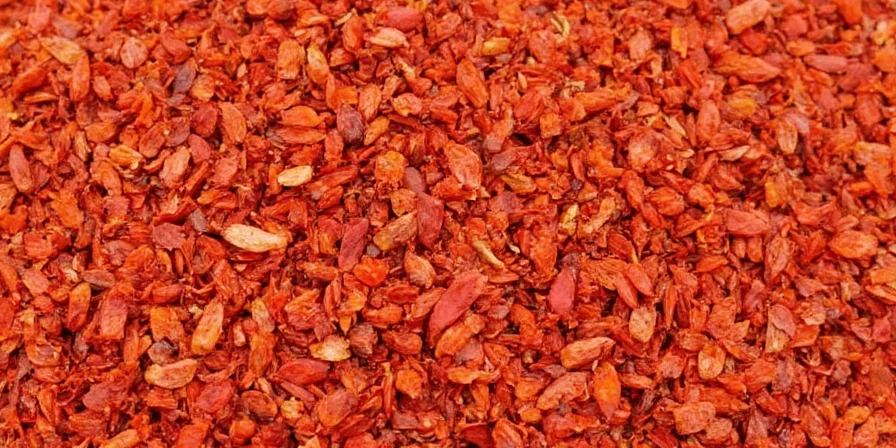Red pepper flakes are dried, crushed fragments of mature red chili peppers, primarily made from cayenne, jalapeño, or regional varieties like Hatch chilies. Unlike uniform chili powders, their irregular texture delivers visible heat bursts in dishes—from pasta sauces to morning eggs. This complete guide explains everything you need to know about using, storing, and maximizing this essential spice.
What Are Red Pepper Flakes? Quick Answer
Red pepper flakes consist of dried, coarsely ground chili peppers with seeds and membranes included. They provide both visual appeal and controlled heat release in cooking, making them ideal for dishes where texture and spice distribution matter. The most common varieties used include cayenne (30,000-50,000 SHU), jalapeño (2,500-8,000 SHU), and regional specialties like Hatch chilies.

Table of Contents
- Flavor Profile: Heat Levels Explained
- How to Use Red Pepper Flakes Properly
- Health Benefits: What Research Shows
- How to Store Red Pepper Flakes for Maximum Freshness
- Red Pepper Flakes vs Chili Powder: Key Differences
- Frequently Asked Questions
Flavor Profile: Heat Levels Explained
Understanding heat intensity prevents culinary mishaps. The Scoville scale measures spiciness, with higher numbers indicating more heat:
| Type of Pepper | Scoville Heat Units (SHU) | Flavor Notes |
|---|---|---|
| Cayenne | 30,000 – 50,000 SHU | Earthy, bright, with sharp bite |
| Jalapeño | 2,500 – 8,000 SHU | Grassy, slightly smoky, mild kick |
| Hatch | 2,500 – 30,000 SHU | Variety-dependent; nutty and sweet when roasted |
| Bird's Eye Chili | 50,000 – 100,000 SHU | Super spicy, citrusy punch |
Key Insight: Seed removal reduces heat by 30-50% while maintaining flavor depth—ideal for balancing spice in family meals.
How to Use Red Pepper Flakes Properly
Maximize flavor impact with these chef-approved techniques:
- Bloom in oil: Heat flakes in oil at 300°F for 90 seconds to unlock complex flavor compounds
- Timing matters: Add early for infused heat, late for fresh punch—never boil for >5 minutes to prevent bitterness
- Balance acidity: Use 1/8 tsp flakes per cup of tomato sauce to enhance sweetness perception
- Texture control: Grind flakes briefly for dressings; use whole for rustic finishes
- Unexpected pairing: Elevate chocolate desserts with a pinch (0.5g) for nuanced heat

Health Benefits: What Research Shows
Capsaicin—the active compound—triggers measurable physiological responses according to 2025 studies:
- Metabolic boost: Increases calorie burn by 4-5% for 3 hours post-consumption
- Pain relief: Topical application reduces neuropathic pain signals
- Vitamin content: One tsp provides 44% daily vitamin A and 16% vitamin C
- Digestive support: Triggers gastric mucus production at moderate doses
Important: Benefits diminish after 6 months of storage—prioritize freshness for maximum effect.

How to Store Red Pepper Flakes for Maximum Freshness
Flavor degradation starts immediately upon exposure. Follow these storage protocols:
- Store in amber glass containers to block UV light—the #1 cause of capsaicin breakdown
- Maintain humidity below 60%—include silica packs in storage jars
- Freeze in vacuum-sealed bags for 2+ years (thaw before use)
- Discard when color fades from vibrant red to dull brown

Red Pepper Flakes vs Chili Powder: Key Differences
Understanding these distinctions prevents recipe failures:
| Feature | Red Pepper Flakes | Chili Powder |
|---|---|---|
| Texture | Coarse, visible flakes | Fine, uniform powder |
| Heat Distribution | Spotty heat bursts | Even heat throughout |
| Best For | Finishing dishes, rustic cooking | Sauces, rubs, baking |
| Substitution Ratio | 1:1 for visual appeal | Use 1/2 volume of flakes |
Frequently Asked Questions
What's the difference between red pepper flakes and chili powder?
Flakes retain fibrous pepper structure for textured heat bursts, while chili powder is uniformly ground. Flakes offer visual appeal and controlled heat release; powders integrate seamlessly into sauces.
How can I reduce spiciness if I add too many flakes?
Acid neutralizes capsaicin—stir in lemon juice or vinegar (1 tsp per cup of sauce). Dairy provides temporary relief but alters texture. Never add water—it spreads heat.
How long do red pepper flakes last?
Properly stored, red pepper flakes maintain optimal flavor for 1-2 years. Discard when color fades from vibrant red to dull brown, indicating significant potency loss.
Are red pepper flakes healthy?
Yes in moderation. They provide vitamins A and C, boost metabolism, and aid digestion. One teaspoon contains 44% daily vitamin A. Benefits diminish after 6 months as capsaicin degrades.
Final Thoughts
Red pepper flakes transform ordinary dishes through their unique texture and controlled heat release. By understanding their proper usage, storage requirements, and differences from similar spices, you can confidently enhance meals from breakfast to dessert. Start with small amounts, experiment with blooming techniques, and always prioritize freshness for the best flavor results. This versatile pantry staple deserves a permanent place in your cooking toolkit.











 浙公网安备
33010002000092号
浙公网安备
33010002000092号 浙B2-20120091-4
浙B2-20120091-4